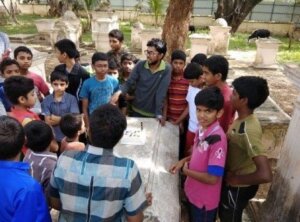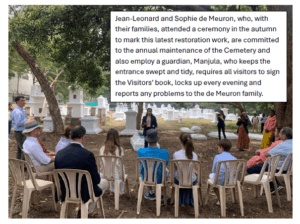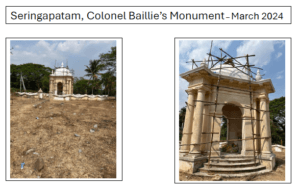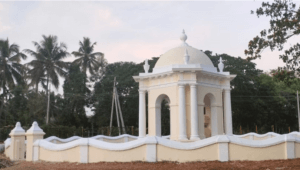Famous for centuries as a place of pilgrimage in Karnataka, Srirangapatna (formerly known as ‘Seringapatam’), is especially remembered as the place where Tipu Sultan was killed in 1799, thus bringing to an end the Fourth Anglo-Mysore War.
Phillida Purvis, the BACSA Area Representative for Seringapatam and Nilgiris, regularly visits the Garrison Cemetery, and Colonel Baillie’s Monument, at Srirangapatna, and reports on the ongoing conservation work – most recently at the BACSA AGM on 21 March 2024.
Garrison Cemetery, Seringapatam
Situated on the banks of the river Cauvery, near the Bangalore – Mysore Highway, Garrison Cemetery holds just over 300 graves of the European officers killed in the final assault on Tipu Sultan in 1799. This includes 80 graves of Officers in the Swiss de Meuron regiment (named after its commander, Colonel Charles-Daniel de Meuron), who joined forces with the British East India Company in the war against Tipu.

(Photo: Phillida Purvis, 2017)
Following their 2007 visit to the Cemetery, Louis Dominique de Meuron, a descendant, and his wife Monique arranged for the badly overgrown graves to be restored by RGRA (Ravi Gundu Rao & Associates), a Mysore heritage preservation agency. The Cemetery is visited by descendants of the soldiers, and others interested in the history of Mysore / Srirangapatna, and is becoming well-known on the tourist itinerary.

(Phillida Purvis, 2024)
Since the demise of Louis and Monique de Meuron, an ongoing programme of conservation work, involving clearing vegetation, as well as repairing and repainting tombs, is being supported by their son Jean-Leonard de Meuron, and their daughter Dr Sophie Sallès de Meuron.
The local community has also been engaged. In 2017 Phillida mentioned that ‘A teacher and pupils from a nearby school are engaged in regular cleanup activities and are exploring ways to attract more visitors to the cemetery’. Shortly afterwards BACSA gave £2,000 to support the de Meuron family project to ‘carry out conservation work on graves, erect improved signage and construct a chowkidar’s hut’.
By 2023 further repairs were needed at the Cemetery, including to the entrance gate, and to a boundary wall severely damaged by an unauthorised drain. Regular maintenance is now ongoing, thanks to de Meuron family support. BACSA AR Phillida Purvis arranged for QR codes to be displayed, linking to a CAD map and burial data on the BACSA website.

(Photo: Phillida Purvis, 2024)
A ceremony to celebrate completion of the conservation work was held on 31st October, with several members of the de Meuron family visiting from Switzerland and the UK.
Colonel Baillie’s Monument
Lieutenant-Colonel William Baillie was captured by Hyder Ali (the father of Tipu Sultan) during the Battle of Pollilur (‘Perambaukan’) in 1780 and died, in captivity, on 13 November 1782. This ‘austere but poignant and pretty’ memorial, located next to the Gumbaz (the Muslim mausoleum where Tipu Sultan and his parents are buried), was commissioned by Baillie’s nephew Lieutenant-Colonel John Baillie some 35 years later.

(Phillida Purvis, 2024)
The inscription on the memorial tablet reads:
‘To the Memory of Colonel William Baillie, who, with a detachment of troops under his command, after a most noble and most gallant resistance to a superior force on the plains of Perambaukan, was ultimately compelled to surrender to the united armies of Hyder Ali and Tipoo Sultan on the 10th day of September 1780, and died in the fortress of Seringapatam on the 13th day of November 1782. This monument erected by his nephew Lieut Colonel John Baillie on the Establishment of Bengal, and Resident at Lucknow, 1816’ (Chowkidar, Spring 2011).
Along with the de Meuron, Baillie and Tritton families, BACSA contributed to the restoration of the memorial by the same heritage architect, Ravi Gundu Rao, in 2010. A rededication service attended by descendants from the Baillie and Tritton families was held on 13 November 2010, the 228th anniversary of Baillie’s death.
A review of the 2013 book When The Tiger Fought the Thistle: The Tragedy of Colonel William Baillie of the Madras Army by BACSA Vice President Alan Tritton (whose mother was a Baillie descendant) was published in the Spring 2014 issue of Chowkidar (Vol 13, No.5,p.110).
In 2017 Phillida Purvis reported that an unsightly wall had recently been built alongside the memorial, which falls under the control of the Karnataka WAQF board (Phillida explains: ‘WAQF is a permanent dedication of movable or immovable properties for religious, pious or charitable purposes as recognized by Muslim Law, given by philanthropists’). Because of its proximity to Tipu Sultan’s Gumbaz, this has made the memorial a little more difficult to access.
In 2023 BACSA contributed £600 to further conservation work on Colonel Baillie’s monument (which needed finials replacing) and its perimeter wall, and was mainly ‘funded privately by BACSA members’.

(Photo: Phillida Purvis, June 2024)
As Phillida writes: ‘’Thanks to the efforts of Heritage Matters, the monument is now looking wonderful!’
Phillida Purvis and Rachel Magowan
(Suggestions for BACSA website news items are always welcome – please send them to ‘comms@bacsa.org.uk’)
